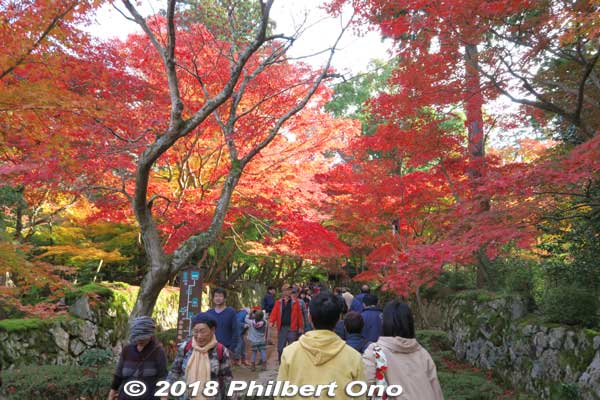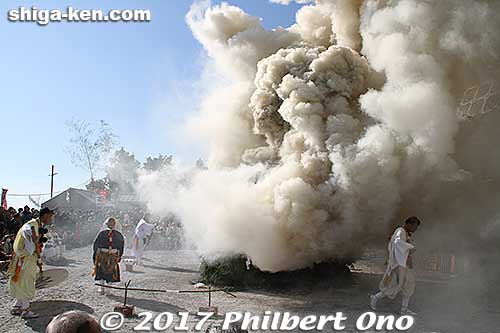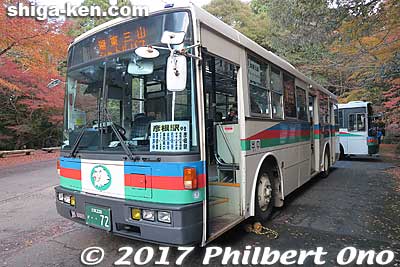Recommended festivals (matsuri), events, exhibitions, and fall leaves in Shiga Prefecture in November–December 2016. (Most official Web sites are in Japanese only.)
Compiled by Philbert Ono. Updated: Nov. 26, 2016
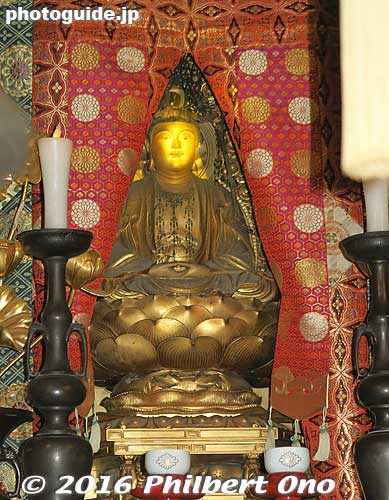
November 8–27, 2016, 8 am–5 pm
♦ Eigenji Hidden Buddha Display (本尊『如意輪観世音菩薩』の御開扉), Higashi-Omi
Eigenji is one of Higashi-Omi’s major temples, famous for autumn leaves. This month in November 2016, they will be showing their hidden Kannon statue for the first time in 30 years. It is the temple’s main object of worship is 60 cm high with a peaceful, golden face. A smaller Buddha said to have been carried by Genko is also on the top of the Kannon’s head. It is to mark the 650th anniversary of Zen Rinzai Sect priest and poet Jakushitsu Genko (寂室 元光 1290-1367) who founded Eigenji. From Ohmi Railways Yokaichi Station, go to Bus stop 1 and take the bus going to Eigenji Shako (永源寺車庫) and get off at Eigenji-mae (永源寺前). Takes about 35 min. Bus schedule from Yokaichi Station on weekdays | Saturday| Sunday.
Temple admission: ¥500
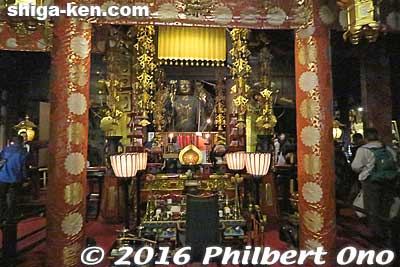
March 18–December 4, 2016, 9 am–4 pm
♦ Ishiyama-dera Hidden Buddha Display (本尊『如意輪観世音菩薩』の御開扉), Otsu
Ishiyama-dera is one of Otsu’s main temples and attractions, famous as the place supposedly where Lady Murasaki wrote the epic novel The Tale of Genji (Genji Monogatari). The temple’s main object of worship is a seated Kannon statue (Important Cultural Property) three meters high and normally behind closed doors in the main Hondo hall (National Treasure). This year in 2016, this main Kannon statue is open for public viewing. They open this Kannon statue’s doors only once every 33 years! The main Kannon statue is a Nyoirin Kannon (Omnipotent One) with six arms dating from around 1096. It is worshiped for finding a marriage partner, safe childbirth, and happiness and prosperity. They say that it is Japan’s only Kannon that was ordered by the emperor to stay hidden (勅封秘仏). Because of its large size, it’s truly awesome. You may have to stand in line for a few minutes before you can see the statue. It has so much detail. Quite breathtaking and surprisingly it’s not a National Treasure (but an Important Cultural Property). (Photography of the Kannon statue is not allowed.) In addition, they are displaying four little Kannon statues dating from the 7th and 8th centuries that were found inside this main Kannon statue in 2002 (本尊如意輪観音像胎内佛像). A separate admission is charged to view the main Kannon statue. The spacious temple grounds also has autumn leaves and other National Treasure structures like the Tahoto pagoda. For this occasion, they are also allowing people to ring the temple bell (for ¥300) in the tall bell tower. I recommend doing that too, quite unique. Near Ishiyama-dera Station on the Keihan Ishisaka Line accessible from JR Ishiyama Station.
Temple admission: ¥600 + Kannon display ¥500
Official site: http://www.ishiyamadera.or.jp/ishiyamadera/gyouji/gokaihi/index.html
Photos | Map
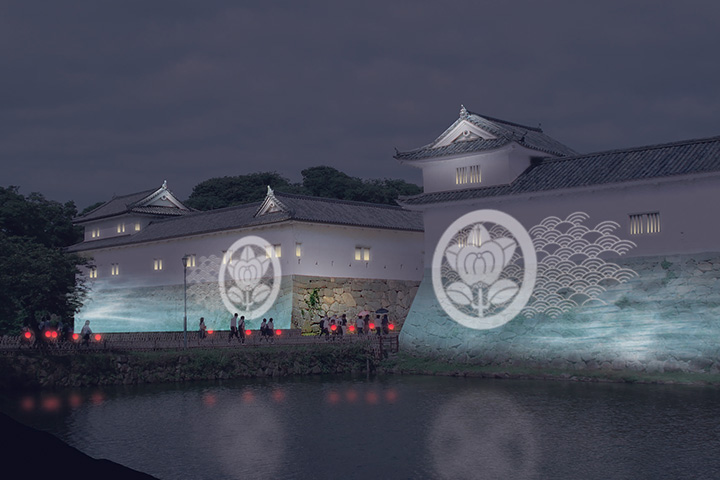
October 1–December 31, 2016 evenings
♦ Light & Art – Dramatic Legacy Castle Light-up, Hikone Castle, Sunset–10:00 pm
New evening event with Hikone Castle’s moat, stone walls, and moatside structures lit up with patterned and colored lighting. Check out the Sawaguchi Tamon turret. Looks beautiful at night.
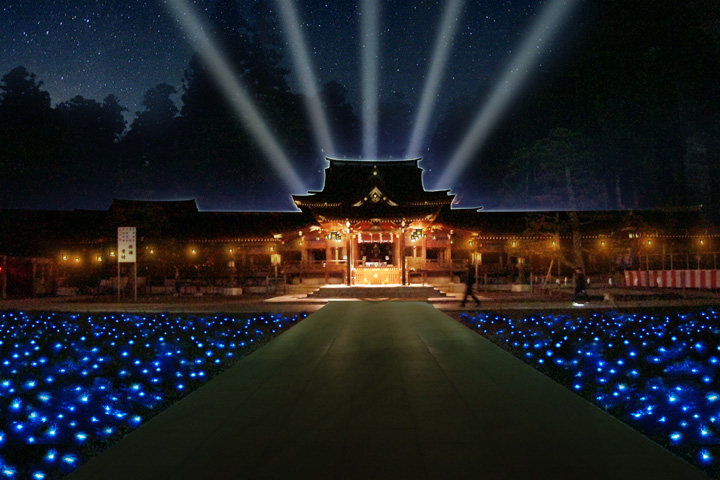
October 1–November 30, 2016 evenings
♦ Light & Art – Dramatic Legacy Shrine Light-up, Taga Taisha Shrine, Sunset–10:00 pm
New evening event with colorful LEDs and laser light shining at the shrine, including tori and trees. Looks surreal and dreamy at night. Special event on Nov. 11, 12, and 13.
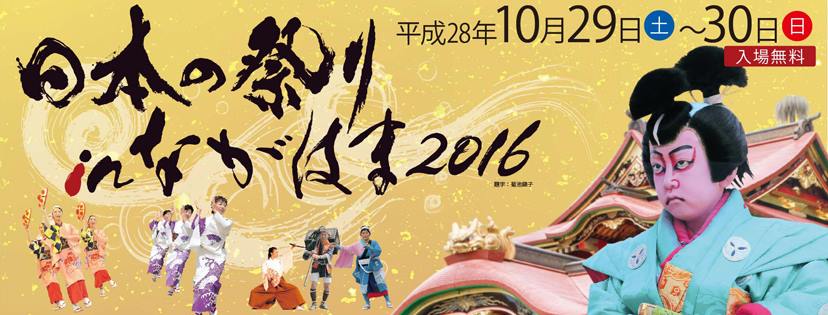
October 29–30, 2016
♦ Japan Matsuri in Nagahama 2016 (日本の祭り in ながはま), Nagahama and Kinomoto
First-time festival extravaganza over the weekend in late Oct. Streets and plazas in central Nagahama near JR Nagahama Station and JR Kinomoto Station will host festivals from Nagahama and other parts of Japan. If you missed seeing this spring’s Nagahama Hikiyama Matsuri, you can see all three hikiyama floats perform in front of the Hikiyama Museum on Oct. 30 from 10 am to 3 pm. Yogo’s Chawan Matsuri will also be performed in Kinomoto on Oct. 30 at 3 pm. Other festivals include Yamagata Hanagasa Matsuri and Awa Odori from Tokushima on Oct. 30 in central Nagahama. Tonda Ningyo Bunraku puppet show, Dosukoi from Kagoshima, and taiko drummers from Shimo-Yogo and Yokaichi (Nagahama) on Oct. 29 in central Nagahama. Omi-Hachiman’s Sagicho will be on Oct. 29 and 30 in central Nagahama. It may be difficult to decide what to see because you can’t see everything. Free admission. They have a pdf in rough English here, but it does not have detailed schedule of events.
Pamphlet in Japanese has detailed schedule: http://matsurinagahama.jp/oshirase01/program.pdf
–

November 3, 2016
♦ Little Edo Hikone Castle Festival Parade, Hikone Castle, 1:00 pm – 3:00 pm
Very elaborate costume parade of mainly kids dressed as samurai and Edo-Period ladies. Highlights include the Hikone Gun Battalion giving a matchlock gun demo (in front of Horse Stable), Ii Naosuke played by an actor on horseback, fireman acrobatics, and Sarugaku dancers. The parade route starts from Joto Elementary School and proceeds along the road to the castle and passes in front of the Umaya Horse Stable. Video here. Short walk from JR Hikone Station. Map | Video | Photos
小江戸彦根の城まつりパレード
English: http://www.hikoneshi.com/en/event/articles/220
Japanese: http://www.hikoneshi.com/jp/event/articles/c/parade
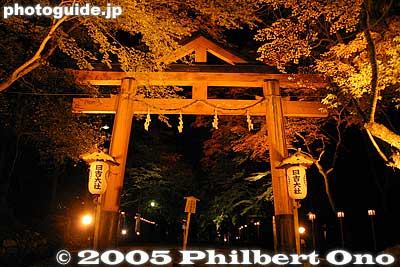
November 12–27, 2016, 5 pm–8:30 pm
♦ Hiyoshi Taisha Shrine Maple Festival Light-up, Otsu
Hiyoshi Taisha Shrine at the foot of Mt. Hie in Otsu, Shiga Prefecture is the head shrine for all Hiyoshi, Hie, and Sanno Shrines in Japan (around 2,000). The spacious grounds includes two shrines that are National Treasures and 3,000 maple trees lit up at night 5:00 pm – 8:30 pm during this period. Even the green leaves look great against the dark sky. Highly recommended if you’re in that part of the city. Near Hiezan Sakamoto Station on the JR Kosei Line and Keihan Line’s Sakamoto Station. Map | Photos
もみじ祭
http://hiyoshitaisha.jp/event/momiji/
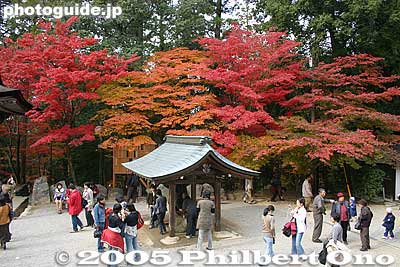
November 19-27, 2016
♦ Koto Sanzan Temple Trio autumn foliage, Kora, Aisho, and Higashi-Omi
Koto Sanzan (湖東三山) is a trio of large Tendai Buddhist temples famous for autumn leaves in eastern Shiga. They are Saimyoji (西明寺) in Kora, Kongorinji (金剛輪寺) in Aisho, and Hyakusaiji (百済寺) in Higashi-Omi (see map below). They are also famous for structures that are National Treasures or Important Cultural Properties.
During the autumn foliage period, convenient shuttle buses (Koto Sanzan Shuttle Bus) run every day between these three temples from Hikone Station and Yokaichi Station. For more details and the shuttle bus schedule in English, click here.

November 6-27, 2016
♦ Eigenji Temple Autumn Foliage and Light-up, Higashi-Omi, 5:00 pm – 8:30 pm for light-up
Although this temple is not one of the Koto Sanzan Temple Trio, it’s also famous for autumn leaves with 3,000 maple trees. Along with Saimyoji, Eigenji is also one of Japan’s 100 Grand Autumn Foliage Sites. Established in 1361, Eigenji belongs to the Zen Rinzai Buddhist Sect (Eigenji School). Since it’s a different sect, Eigenji is not a member of the Koto Sanzan trio of Tendai Sect temples. Impressive during the day, but also beautiful at night when the leaves are illuminated along with the walking paths. Admission 500 yen.
From Ohmi Railways Yokaichi Station, go to Bus stop 1 and take the bus going to Eigenji Shako (永源寺車庫) and get off at Eigenji-mae (永源寺前). Takes about 35 min. Bus schedule from Yokaichi Station on weekdays | Saturday | Sunday. Note that from Eigenji-mae, the last bus for Yokaichi Station leaves at 7:26 pm on Sat./Sun. and 8:27 pm on weekdays. Shuttle buses from Hyakusaiji also run to Eigenji during Nov. 16-Dec. 1. Map
永源寺 ライトアップ
http://eigenji-t.jp
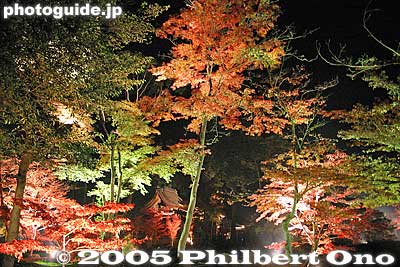
November 17-30, 2016
♦ Hyozu Taisha Shrine Garden Autumn Foliage Light-up, Yasu, 5:00 pm – 8:30 pm (until 9 pm on weekends and holidays)
Established in 717 (Nara Period), Hyozu Taisha Shrine has a noted Japanese garden with a pond ringed by small rolling hills and autumn leaves. The fall leaves certainly look colorful and impressive when illuminated in the evenings and reflected in the pond. Mini concerts will be held during the foliage illumination in the evenings.
A short bus ride from JR Yasu Station’s North Exit (Kita-guchi). Take the Yoshikawa Line (going to Nishi Kawahara 2-chome 西河原2丁目 or Ayame-hama あやめ浜) and get off at Hyozu Taisha 兵主大社. Buses are infrequent (schedule here). The last bus leaving Hyozu Taisha for Yasu Station leaves around 9:02 pm on weekdays and around 7:17 pm on Sat./Sun. Or take a taxi (costing about 2,000 yen from Yasu Station). Map
兵主大社庭園紅葉ライトアップ
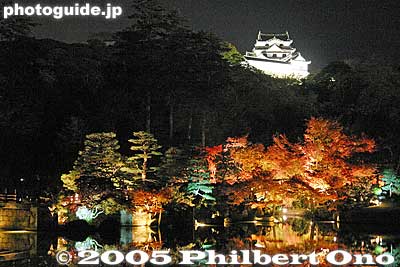
November 12-27, 2016
♦ Genkyuen Garden Autumn Foliage Light-up, Hikone, 6:00 pm – 9:00 pm (enter by 8:30 pm)
Adjacent to Hikone Castle, Genkyuen was built as a castle garden in 1677 by Ii Naooki, the fourth lord of Hikone Castle. I would call this Shiga’s best place to view autumn foliage illumination. The pond’s reflection of the colorful autumn leaves at night doubles the impact. Hikone Castle in the background is also lit up for a perfect night scene. Reminds me of a master painter using a black canvas. Admission ¥700 (¥350 for jr high and younger). Short walk from JR Hikone Station. Map
錦秋の玄宮園ライトアップ
English: http://www.hikoneshi.com/en/event/articles/221
Japanese: http://www.hikoneshi.com/jp/event/articles/c/kinshu

November 13-30, 2016
♦ Konan Sanzan Temple Trio Autumn Tour, Konan, all day
Not to be confused with Koto Sanzan, Konan Sanzan is a trio of Tendai Buddhist temples in the city of Konan. A small city like Konan is lucky to have as many as four National-Treasure structures at the three Konan Sanzan temples. Like Koto Sanzan, Konan Sanzan temples are also noted for autumn leaves. During this period, a convenient shuttle bus plies between the temples and train stations.
The temples are Jorakuji 常楽寺, Chojuji 長寿寺, and Zensuiji 善水時. Jorakuji has not one, but two buildings that are National Treasures: the Hondo main hall and three-story pagoda. Chojuji means, “Long Life Temple,” and its small, but distinctive Hondo hall is a National Treasure. Zensuiji has the largest and most impressive Hondo hall (National Treasure) bearing elegant roof lines. Not to be missed by architectural buffs. The three temples are all in quiet, rural neighborhoods.
One thing you have to understand is that two of the temples (Jorakuji and Chojuji) are on one side of the train tracks and the third temple (Zensuiji) is farther away on the other side of the tracks. So there are two separate bus routes going to the three temples and there’s a train ride between Jorakuji/Chojuji and Zensuiji.
The Konan Community bus called Meguri-kun runs from JR Ishibe Station (JR Kusatsu Line) to Jorakuji and Chojuji once an hour from 8:24 am to 3:45 pm. From Jorakuji, you can take the bus to Chojuji. From Chojuji, take the bus back to JR Ishibe Station and catch the train to JR Kosei Station one stop away. From JR Kosei Station, take the bus to Zensuiji. The last bus leaves Zensuiji at 5:17 pm for JR Kosei Station. You can also tour the temples in reverse order, starting with Zensuiji. In the morning, buses leave JR Kosei Station (north exit kita-guchi) for Zensuiji at 8:28 am, 9:25 am, 10:15 am, 12:20 pm, 1:45 pm, 2:45 pm, 3:50 pm (except on weekends and holidays)
Bus schedule in Japanese | Map
湖南三山めぐり
http://www.burari-konan.jp/konan3zan/
November 12–December 4, 2016, 5:30 pm–8 pm (enter by 7:30 pm)
♦ Kyorinbo Garden Autumn Foliage Light-up, Azuchi, Omi-Hachiman
Beautiful Japanese garden designed by Kobori Enshu. Part of a temple at the foot of Mt. Kinugasa. Autumn foliage at night is reputed to be most beautiful. Of course, you can also go during the day. Tripods/monopods and food are not allowed. No photography inside the buildings. The garden is usually open only on weekends and holidays, but it will be open every day during Nov. 1 to Dec. 15. Admission 500 yen (200 yen for jr high and younger). From JR Azuchi Station, take a taxi for 10-min. ride. Google Map
石の寺 教林坊 紅葉ライトアップ
http://www.d1.dion.ne.jp/~marche/kyourinbou/
December 3–4, 2016
♦ Hot Air Balloon Over Lake Biwa, Takashima, early morning
Dramatic sight of hot-air balloons crossing Lake Biwa. They start off very early in the morning so you would have stay near the launching beach in Takashima. Note that weather conditions can cancel the event.
熱気球琵琶湖横断
http://www.takashima-kanko.jp/
December 4, 2016
♦ Tonda Ningyo Bunraku Puppet Show, Nagahama, 1:30 pm
The famous Tonda Ningyo Bunraku puppet troupe will perform three acts. Admission 1,200 yen at the door.
At JR Nagahama Station, go to Bus stop 1 and take the bus at 12:27 pm going to Nagahama Shiyakusho Azai-shisho-mae (長浜市役所浅井支所前) and get off at Biwa Shisho-mae (びわ支所前). Takes about 20 min. Only three buses go there on Sunday. Or take a taxi if you’re rich or going with friends. Google Map
人形浄瑠璃「冨田人形」
December 4, 2016
♦ Tarobogu Shrine Fire Festival, Higashi-Omi, Noon – 4:00 pm
Held annually on the first Sunday of December, the Tarobo Shrine Fire Festival burns a big pile of 100,000 wooden prayer tablets called goma (護摩) collected from believers all over Japan. The tablet is written with the believer’s name, address, and prayer wish. The fire burns as a prayer for family health and safety. After the fire settles down, barefoot priests walk over the hot ashes. Very dramatic festival (photo here).
Short walk from Ohmi Railways Tarobogu-mae Station. Map
太郎坊宮お火焚大祭
http://www.tarobo.sakura.ne.jp/gyouzi.html
For art and museum exhibitions in Shiga, see Kansai Art Beat’s exhibition schedule for Shiga museums.


